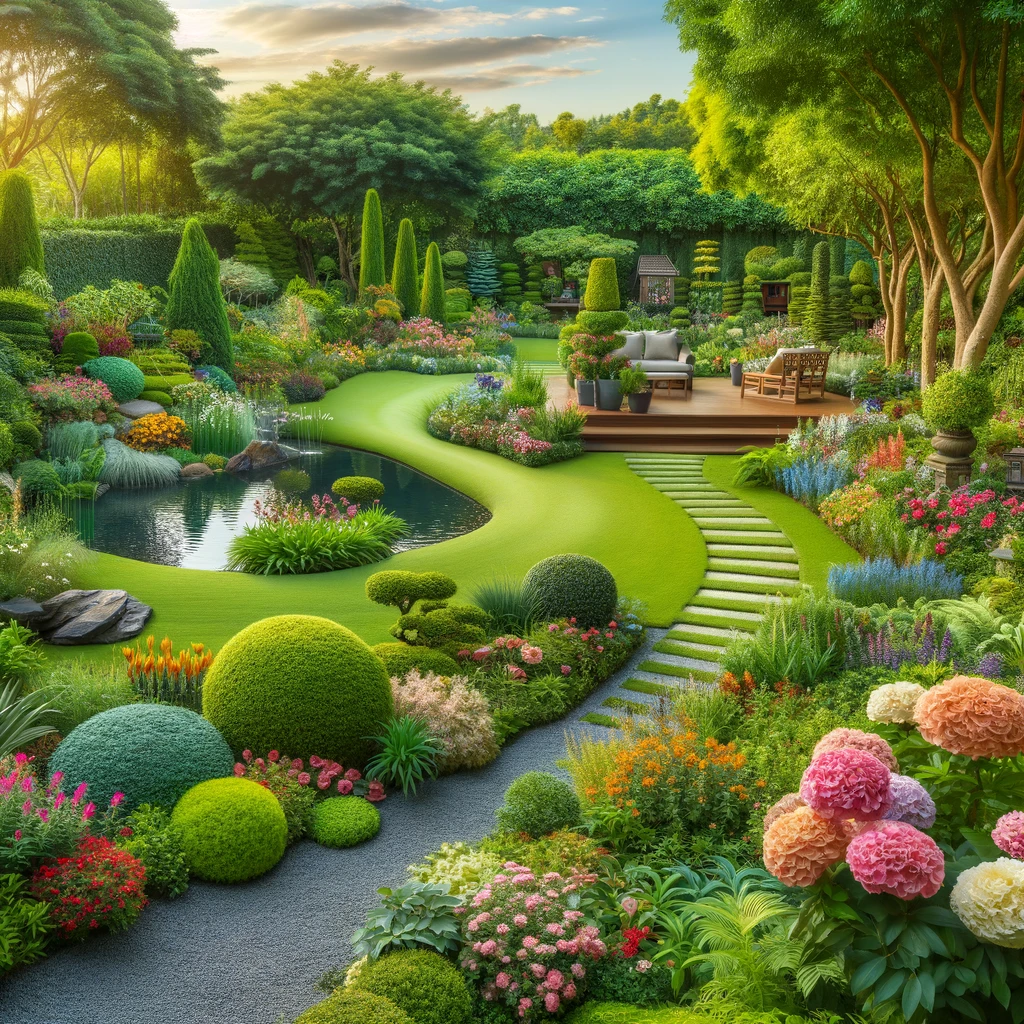
Step 1: Hardscaping and Landscape Edging
Objective: The primary goal is to rejuvenate the edging around planters and trees, thereby establishing a clean, visually appealing boundary that delineates landscaped areas from other parts of the garden or lawn.
Tools & Materials: Utilization of existing stones is encouraged if they remain in a condition suitable for reuse. Additional necessary materials include a pressure washer for cleaning, string for marking layouts, and spray paint for defining edges.
Process:
- Begin by meticulously removing any existing edging stones. Employ a pressure washer to remove dirt and restore their appearance.
- Use string to delineate new edging lines around trees and the planned perimeters of garden beds. Apply marking spray paint along these lines to create visible boundaries for stone placement.
- Carefully lay the stones back into position, ensuring each stone is placed evenly and level with the ground. A rubber mallet may be required to adjust the stones accurately.
Step 2: Pressure Washing
Objective: The aim is to thoroughly clean the exterior surfaces of the house, including siding, driveways, sidewalks, and other concrete areas, to remove accumulated dirt and grime.
Tools & Materials: A pressure washer is the primary tool for this task. For individuals who do not own a pressure washer, rental options are available and recommended.
Tips: Special attention should be paid to surfaces that may not visibly appear dirty. The act of pressure washing can reveal a significant transformation in the appearance of these surfaces, thus contributing markedly to the overall aesthetic appeal of the property.
Step 3: Pruning Overgrown Trees and Shrubs
Objective: The objective is to trim and shape trees and shrubs in order to enhance the visibility of the property and improve the shape and health of the vegetation.
Tools & Materials: Essential tools for this task include pruning tools, such as saws or shears, which are used to remove undesirable branches and foliage.
Process:
- Initiate the pruning process by removing dead or overgrown branches from trees and shrubs. This action serves to clear sightlines, thus improving the visibility of the property, and promotes healthier growth patterns in the plants.
- Proceed to shape the shrubs, aiming to achieve an aesthetically pleasing appearance that complements the overall landscaping design.
Step 4: Weed Control and Mulching
Objective: The primary goal is to eradicate weeds and replace old mulch with a new layer to rejuvenate the appearance of the garden beds, ensuring a fresh and clean aesthetic.
Tools & Materials: The process requires the utilization of weeding tools, garden fabric to inhibit weed growth, a new supply of mulch for coverage, and optionally, no-dig edging to delineate garden areas effectively.
Process:
- Initiate by removing existing mulch and weeds to prepare the beds for a new start. This step is crucial for eliminating competition for nutrients and water, thereby fostering a healthier environment for desired plants.
- Install garden fabric on the cleared soil to act as a barrier against future weed emergence. This fabric is essential for maintaining the cleanliness and ease of care of the garden beds.
- Apply a substantial layer of new mulch over the garden fabric. The thickness of the mulch layer should be sufficient to endure seasonal changes and continue to suppress weed growth effectively, in addition to retaining soil moisture and temperature regulation.
Step 5: Softscaping and Landscape Lighting
Objective: To introduce new plant species and integrate landscape lighting with the dual purpose of enhancing the garden's visual appeal during the day and illuminating its features at night.
Tools & Materials: Selection of plants, such as hydrangeas for their aesthetic value, topsoil to improve planting conditions, and a variety of landscape lights to achieve the desired lighting effects.
Process:
- Conduct an assessment and remove any plant material that detracts from the overall beauty of the garden. This includes dead or diseased plants and those that no longer fit the garden’s design scheme.
- Introduce new plantings, carefully mixing the existing soil with topsoil to optimize the conditions for plant growth. This step is vital for ensuring the health and vibrancy of new additions to the garden.
- Implement a strategic plan for landscape lighting. This involves the selection and placement of lights to accentuate key elements of the garden, combining both solar and hardwired options to create a balanced and inviting nighttime environment.
Additional Tips for Landscaping Success
- Garden Bed Layout: Effective planning of garden bed layouts is essential. Utilize a hose for flexible edge designs and a string for straight edges. Prior to making any modifications, it is advisable to outline the intended layout with spray paint on the ground.
- Pruning: Equip a reciprocating saw with a pruning blade for an efficient and safe method to trim trees and shrubs. This approach offers a practical alternative to the chainsaw, reducing the risk of damage to the operator and plant.
- Planting and Lawn Care: Enhance the planting process by using an auger attachment with a drill, simplifying the creation of planting holes. Incorporating starter fertilizer into the planting holes can significantly improve plant establishment and growth.
- Concrete Maintenance: For the repair of cracks in concrete paths or driveways, the application of a concrete crack filler, such as those offered by DAP, provides a reliable solution for restoring surface integrity and appearance.
- Outdoor Lighting: A comprehensive exploration of outdoor lighting options can significantly enhance the nighttime appeal of a garden. Selecting the appropriate mix of lighting types can transform the outdoor space into an inviting and well-lit haven






